Drake G.W.F. (editor) Handbook of Atomic, Molecular, and Optical Physics
Подождите немного. Документ загружается.

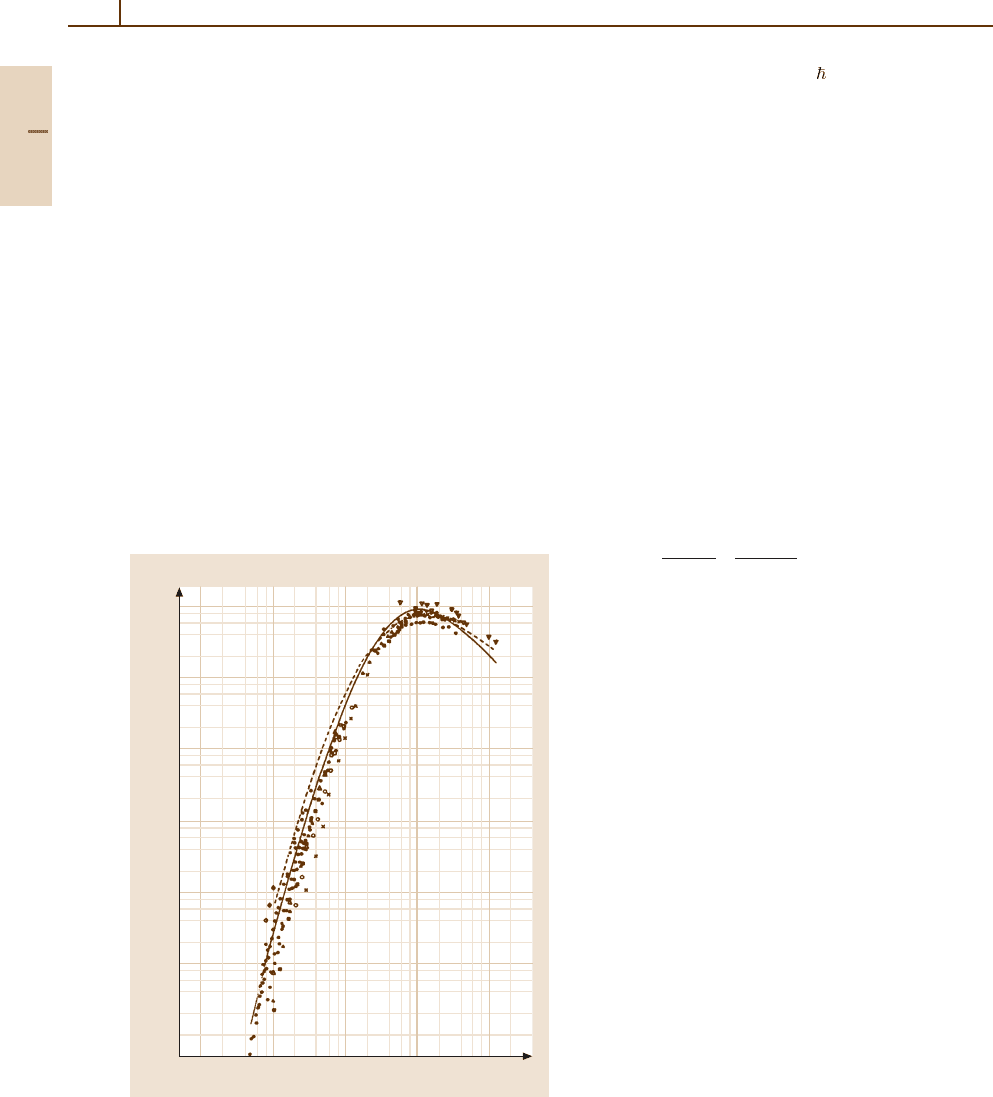
952 Part E Scattering Experiment
where θ
2
= 2u
k
n
2
/Z
2
2
and u
k
is the target binding en-
ergy. The function f rises rapidly for V <v
e
, reaching
a value near unity near V = v
e
and falling very slowly
thereafter. Tables of f for K- and L-shell ionization
are given in [65.3, 4]. Figure 65.1 shows a compari-
son of experimental data for K vacancy production by
protons with PWBA calculations, and with a classical bi-
nary encounter approximation [65.12] for a large range
of proton data [65.6]. For larger Z
1
, corrections to the
PWBA and SCA must be made for the effective increase
of u
k
due to the presence of the projectile during the
ionization, for nuclear projectile deflection, for relativis-
tic corrections, and for the polarization of the electron
cloud, as reviewed in [65.13–17]. Total cross section
measurements for inner shell vacancy production in the
perturbative region are reviewed in [65.15, 16].
In the SCA treatment, the heavy particle motion
is taken to be classical, and the evolution of the elec-
tronic wave function under the influence of the projectile
field is calculated by time-dependent perturbation the-
ory. The assumption of classical motion is valid if the
10
–19
10
–20
10
–21
10
–22
10
–23
10
–24
10
–25
10
–3
10
–2
10
–1
10
0
10
1
U
2
k
σ
k
/Z
1
2
(keV
2
cm
2
)
E/λU
k
Fig. 65.1 Comparison of experimental cross sections for
K-shell vacancy production with PWBA (dashed) and bi-
nary encounter (solid) theories. U
k
is the target binding
energy in keV and λ the projectile/electron mass ratio [65.6]
Bohr parameter K = 2Z
1
Z
2
e
2
/( V ) is much larger than
unity [65.18]. If this condition is satisfied, the projec-
tile scattering angle can be associated with a particular b
through a classical deflection function. For K-shell ion-
ization, the action occurs typically at sufficiently small b
that a screened Coulomb potential is sufficient for cal-
culating the deflection. In the absence of screening,
θ =r
0
/b,wherer
0
= Z
1
Z
2
e
2
/E with θ and E expressed
in either the laboratory or c.m. system. Calculations for
K- and L-shell ionization have been carried out [65.10].
The typical ionization probability P(b) for V ∼ v
e
and
b = 0isP(0) ∼ (Z
1
/Z
2
)
2
.ForV <v
e
, P(b) decreases
with increasing b with a characteristic scale length of
r
ad
= V/ω,theadiabatic radius,whereω is the transition
energy. For V >v
e
, P(b) cuts off near the K-shell radius
of the target. A more sophisticated relativistic SCA pro-
gram has been written [65.19], and is widely used for
calculating P(b), cross sections, and probabilities differ-
ential in final electron energy and angle. Experimentally,
the probability P(b) for inner shell ionization can be
determined from
P(b) =
1
ω∆Ω
Y
N[θ(b)]
,
(65.2)
where Y is the coincidence yield for the scattering of
N(θ) ions into a well-defined angle θ(b) accompanied
by X-ray (or Auger electron) emission with fluorescence
yield ω into a detector of efficiency and solid angle ∆Ω
[65.20]. The necessary ω can be obtained from calcu-
lations for neutral targets [65.21](Chapt.62). However,
they must be corrected for changes due to extensive outer
shell ionization during the collision. Such corrections are
particularly important for targets with low fluorescence
yields, for Z
2
below 30, and for collisions in which the
L-shell is nearly depleted in the collision [65.15,16]. Val-
ues of P(b) have been measured for many systems and
generally show good agreement (better than 10%) with
the SCA for fast light projectiles such as protons, with
increasing deviation as higher Z
1
or slower V are used
[65.22]. Examples of P(b) for K vacancy production for
several systems are shown in Fig. 65.2, showing the evo-
lution away from the SCA as the collision becomes less
perturbative.
Ionization of Light Target Atoms
Ionization of light target atoms by bare ion impact is
a particularly suitable process to study the atomic few-
body problem. In the case of an atomic hydrogen target
the collision represents a three-body system, i. e., the
simplest system for which the Schrödinger equation is
not analytically solvable. However, because of the ex-
Part E 65.1
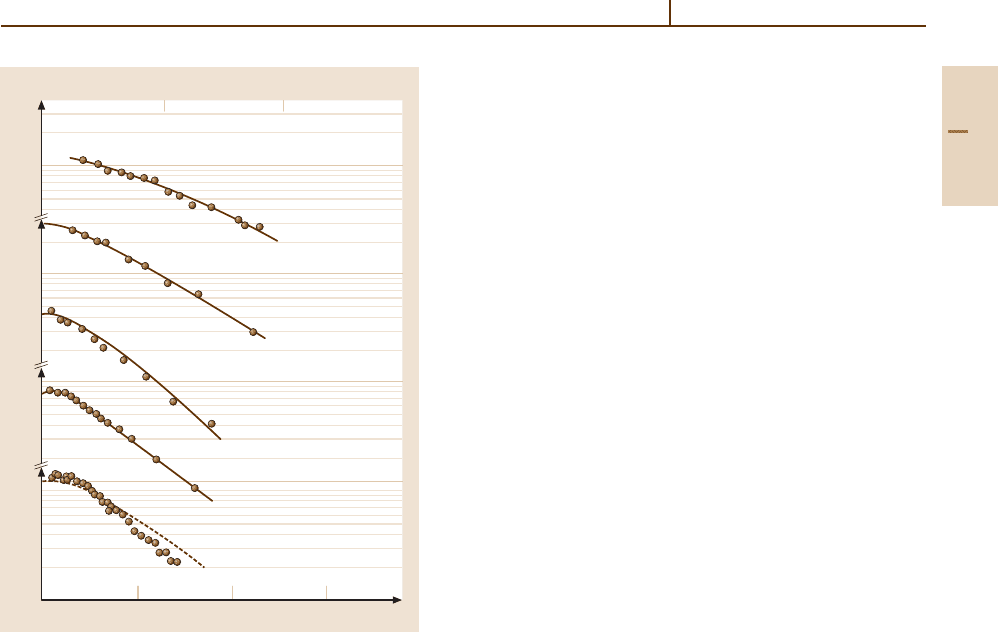
Ion–Atom Collisions – High Energy 65.1 Basic One-Electron Processes 953
10
–3
10
–3
10
–3
10
–3
1.0 2.0 3.0
b/r
ad
P(b)/ Z
2
1
Projectile/Target
Z
2
/Z
1
2.0
3.0
3.62
7.25
29
0.52
0.52
0.35
0.35
0.35
F(5+)/Ar
C(4+)/Ar
O(6+)/Cu
Be/Cu
p/Cu
SCA
Fig. 65.2 P(b) for K-shell vacancy production versus b/r
ad
for several systems (see text). The ratio V/v
e
is desig-
nated as “V” in this figure. For protons p, agreement with
the SCA theory is found [65.10], while for higher Z
1
/Z
2
,
P(b) moves to larger impact parameters as one leaves the
perturbative region [65.22]
perimental difficulties associated with atomic hydrogen,
measurements with this target species are rare [65.23]
and experimental studies have focused on helium tar-
gets. Here, the collision still constitutes a relatively
simple four-body system. With regard to the few-body
problem, studies of ionization processes have the im-
portant advantage that, in contrast to pure excitation and
capture processes, the final state involves at least three
independently moving particles.
Detailed information about the few-body dynamics
in a collision can be extracted from multiply differential
measurements. This can be accomplished by measur-
ing the kinematic properties (e.g., energy, momentum,
ejection angle) of one or more of the collision frag-
ments. The first experimental multiply differential single
ionization cross sections were obtained by studying
the ionized electron spectra as a function of energy
and ejection angle. Such studies were reviewed by
Rudd et al. [65.24] and are discussed in more detail
in Sect. 65.3. More recently, complementary multiply
differential data were obtained by measuring projectile
energy-loss spectra as a function of scattering angle in
p+He collisions [65.25, 26].
A comprehensive picture of ionizing collisions can
be obtained from kinematically complete experiments.
In such a study the momentum vectors of all collision
fragments need to be determined. However, in the case
of single ionization it is sufficient to directly measure
the momentum vectors of any two particles in the final
state; the third one is then readily determined by mo-
mentum conservation. For ionization by electron impact,
this has been accomplished by momentum-analyzing
the scattered and the ionized electrons (for a review
see [65.27]). For ion impact, this approach is difficult
because of the very small scattering angles and energy
losses (relative to the initial collision energy) resulting
from the large projectile mass. Consequently, the only
kinematically complete experiments involving a direct
projectile-momentum analysis were reported for light
ions at relatively low projectile energies [65.28]. For
heavy-ion impact at high projectile energies, in con-
trast, the complete determination of the final space state
is only possible through a direct measurement of the
ionized electron and recoil-ion momenta [65.29].
The technology to measure recoil-ion momenta with
sufficient resolution, and therefore to perform kinemat-
ically complete experiments for heavy-ion impact, has
only become available over the last decade (for re-
views, see [65.30–32]). Figure 65.3 shows measured
(top) and calculated (bottom) three-dimensional angu-
lar distributions of electrons ionized in 100 MeV/a.m.u.
C
6+
+He collisions for fully determined kinematic con-
ditions [65.33]. The arrows labeled p
o
and q indicate
the direction of the initial projectile momentum and the
momentum transfer defined as the difference between
p
0
and the final projectile momentum p
f
.Thisplotis
rich in information about the dynamics of the ioniza-
tion process. The main feature is a pronounced peak in
the direction of q. It can be explained in terms of a bi-
nary interaction between the projectile and the electron,
i. e., a first-order process, and is thus dubbed the “Bi-
nary Peak”. A second, significantly smaller, structure is
a contribution centered on the direction of −q (called the
“Recoil Peak”). This has been interpreted as a two-step
mechanism where the electron is initially kicked by the
projectile in the direction of q and then backscattered by
the residual target ion by 180
◦
. Although this process in-
volves two interactions of the electron, it is nevertheless
a first-order process in the projectile–target atom inter-
Part E 65.1
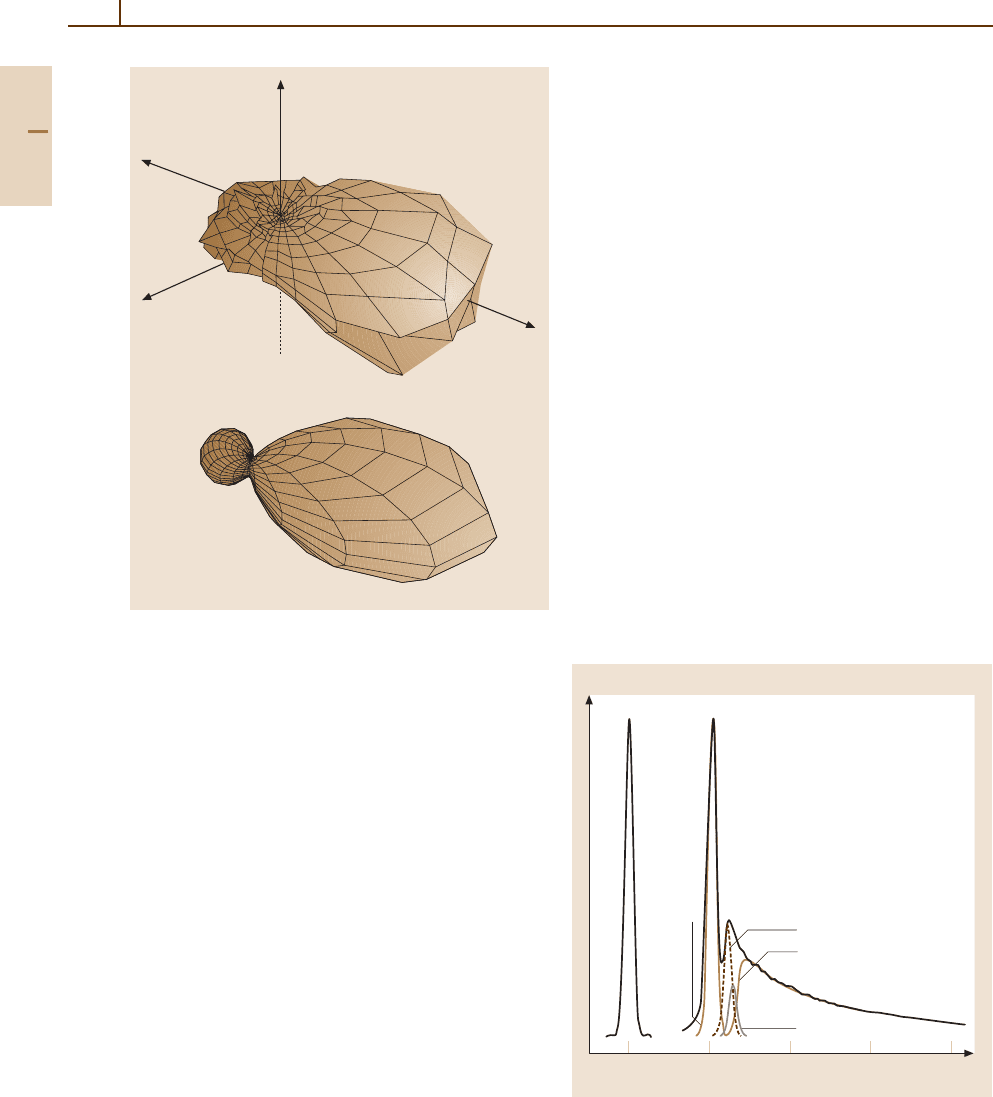
954 Part E Scattering Experiment
y
x
P
0
(z-axis)
q
Fig. 65.3 Three-dimensional angular distribution for fully
determined kinematic conditions of electrons ionized in
100 MeV/a.m.u. C
6+
+He collisions. To p, experimental
data; bottom, CDW calculation (see text)
action. Therefore, as expected for this very large value
of η
1
= 100 (in a.u.), the ionization cross sections are
dominated by first-order contributions.
The basic features of the data in Fig. 65.3 are
well reproduced even by the relatively simple first
Born approximation (FBA). Furthermore, the calcula-
tion shown in the bottom of Fig. 65.3, which is based
on the more sophisticated continuum distorted wave ap-
proach (CDW)([65.35–37] see also Chapt. 52), yields
practically identical results to the FBA.IntheCDW
method, higher-order contributions are accounted for
in the final-state scattering wavefunction. Apart from
this good overall agreement, a closer inspection of the
comparison between experiment and theory also reveals
some significant discrepancies. While in the calculation
the Binary and Recoil peaks are sharply separated by
a minimum near the origin, in the data this minimum
is almost completely filled up giving rise to a “ring-
like” shape of the recoil peak. This was explained by
a higher-order ionization mechanism involving an in-
teraction between the projectile and the residual target
ion [65.33,37,38]. Although the contribution of this pro-
cess to the total cross section is negligible, it is a very
surprising result that for selected kinematic conditions
higher-order processes can be important even at large
projectile energies. A sobering conclusion of recent re-
search on ionization of light target atoms is that evenwell
inside the perturbativeregimethe atomic few-body prob-
lem is not nearly as well understood as was previously
assumed based on studies for restricted collision geom-
etries. At large perturbation, the lack of understanding
is dramatic [65.39].
Excitation
Inner shell excitation can be treated within the same
perturbative framework, which leads to a cross section
given in terms of the generalized oscillator strength for
the transition [65.40–42]. For inner shell vacancy pro-
duction by light projectiles, the excitation is generally
much smaller than the ionization, since the strongest os-
cillator strengths are to low-lying occupied orbitals, as
reviewed by Inokuti [65.41]. Excitation cross sections
can be deduced from photon production cross sections
and from inelastic energy loss experiments. An example
of the cross section for excitation of the n = 2levelofH
by protons, measured by the latter technique, is shown
in Fig. 65.4 [65.34].
0 10203040
Energy loss (eV)
Contributions of individual terms in dσ/dξ
σ(n =4)
σ(n =3)
Continuum terms
σ(n =2)
Fig. 65.4 Energy loss spectrum for 50 keV protons in
atomic hydrogen, showing excitation to discrete states in
H proceeding smoothly into ionization at the continuum
limit [65.34]
Part E 65.1

Ion–Atom Collisions – High Energy 65.1 Basic One-Electron Processes 955
Capture
As Z
1
/Z
2
is raised, the probability for direct trans-
fer of inner shell electrons from projectile to target
becomes competitive with, and can even exceed, that
for ionization of the target electron into the continuum.
The first-order perturbation treatment for electron cap-
ture, given by Oppenheimer [65.43] and by Brinkman
and Kramers [65.44](OBK) ([65.11], p. 379) results in
a cross section per atom
σ
OBK
= 2
9
π(Z
1
Z
2
)
5
/5 V
2
ν
5
n
3
β
5
a
2
0
, (65.3)
from a filled shell ν to all final states n,where
β =
1
4
V
2
V
4
+2V
2
Z
2
2
/ν
2
+ Z
2
1
/n
2
+
Z
2
2
/ν
2
− Z
2
1
/n
2
2
.
(65.4)
Both the PWBA/SCA and the OBK cross sections
maximize near the matching velocity, but the OBK falls
off much more strongly with increasing V beyond this,
eventually falling as V
−12
, while the ionization cross
section only falls as V
−2
ln V .TheOBK amplitude for
capture is simply the momentum space overlap of the
initial wave function with the final state wave func-
tion, where the latter is simply a bound state on the
projectile but moving at a velocity V relative to the
initial bound state. The integral is done only over the
transverse momentum, since the longitudinal momen-
tum transfer is fixed by energy conservation [65.11].
This capture amplitude thus depends heavily on there
being enough momentum present in the initial and/or
final wave function to enable the transfer, and the loss of
this match is what leads to the steep decrease in the OBK
cross section above velocity matching. Cross sections
for K-shell capture have been measured by detection of
K Auger electrons and K X-rays in coincidence with
charge capture by the projectiles [65.22, 45,46]. On the
basis of these and many other data on electron cap-
ture, the OBK is a factor of approximately three too
large [65.45–48]. This factor comes from a fundamental
failure of first-order perturbation theory for electron cap-
ture. As pointed out already in 1927 by Thomas [65.49],
who proposed a classical two-collision mechanism for
capture, it is essential that the electron interacts with
both nuclei during the collision in order to be captured
(Chapt. 57). In quantum theories, this corresponds to the
fundamental need to include second-order terms (and
higher) in the capture amplitude. In the limit of large V,
the second-order cross section decreases more slowly
than the OBK term, as V
−10
, and thus is asymptotically
larger than the first-order term [65.50]. At large V ,the
coefficient of the V
−12
term, the dominant one at most
experimentally reachable V ,is0.29 times the OBK cross
section when the theory is carried out to second-order
in the projectile potential [65.50,51]. Roughly speaking,
this provides an explanation for the factor of three. Much
more sophisticated treatments of high velocity capture
are now available [65.52–60]. The underlying role of
the second-order scattering process was confirmed ex-
perimentally by the detection of the Thomas peak in the
angular distribution of protons capturing electrons from
He and H [65.61,62](Chapt.57).
In spite of the basic importance of second-order
amplitudes in perturbative capture, the OBK gives an
excellent account of the relative contributions from and
to different final shells over a large range of V above v
e
,
and is thus, when appropriately reduced, still useful as an
estimate for perturbative capture cross sections between
well defined ν and n for large V .
For electron capture, as in the case of ionization (see
previous section), the development of recoil-ion mo-
mentum spectroscopy (RIMS) has enabled much more
detailed studies of the collision dynamics. The trans-
verse (perpendicular to the beam direction) recoil-ion
momentum component p
⊥
reflects the closeness of the
collision both relative to the target nucleus and the elec-
trons. The longitudinal (parallel to the beam direction)
component p
z
, on the other hand, is related to the internal
energy transfer Q in the collision by (in a.u.)
p
z
=−Q/V −nV/2 , (65.5)
where n is the number of captured electrons. A meas-
urement of p
z
is therefore equivalent to a measurement
of Q. The advantage over measuring Q from the projec-
tile energy loss is that at large collision energies a much
better energy resolution is achievable. A sample Q meas-
urement with RIMS is shown in Fig. 65.5 [65.63]. Very
recently, RIMS was applied to study capture processes
in collisions with an atomic hydrogen target [65.64].
This could be an important breakthrough in advancing
our understanding of the atomic few-body problem as it
opens the possibility to perform kinematically complete
experiments on the true three-body system X
Z+
+H,
where X can be any bare projectile.
65.1.2 Nonperturbative Processes
Fano–Lichten Model
When the collision becomes increasingly perturba-
tive, either due to a decreased V or increased Z
1
/Z
2
,
higher-order effects become generally more impor-
tant. One approach to account for such contributions
Part E 65.1

956 Part E Scattering Experiment
–3 –2 –1 0 1
Counts (arb. units)
P
rec
(a.u.)
0.25 MeVHe
2+
+ He– – He
1+
(n) + He
1+
(n)
(1, 2) & (2, 1)
(n, n)=
(1, 1)
0.26 a.u.
FWHM
(1,3)&(3, 1)
(2, 2)
Fig. 65.5 Longitudinal momentum spectrum of recoil ions
from 0.25 MeVHe
2+
capturing a single electron from a cold
He target, showing clear resolution of capture to n = 1 from
that which leaves target or projectile excited [65.63]
is the continuum distorted wave–eikonal initial state
(CDW-EIS)model ([65.35, 36, 65], see also Chapt. 52
and Sect. 65.1.1). The range of validity of CDW-EIS is
roughly given by Z
1
/V
2
1 [65.35]. Therefore, if the
perturbation is large due to the projectile charge, the col-
lision may still be treated perturbatively provided that
the collision energy is sufficiently large. Otherwise, the
perturbation treatment is replaced by a molecular orbital
treatment.
Fano and Lichten [65.67] pointed out that the ra-
tio V/v
e
can be small for inner orbitals even for V
of several a.u., and thus an adiabatic picture of the
collision holds. K vacancy production cross sections
become much larger than the perturbation treatments
above predict and extend to much larger b.Inthemo-
lecular orbital picture, the collision system is described
in terms of time-dependent molecular orbitals (MO)
formed when the inner shells of the systems overlap.
Vacancy production occurs due to rotational, radial, and
potential coupling terms between these orbitals during
the collision. The independent electron model is used,
but the results in any specific collision are quite sen-
sitive to the occupation numbers (or vacancies) in the
initial orbitals. These are very difficult to control in
ion–atom collisions in solids and even problematic in
gases, since outer shell couplings can produce vacan-
cies at large internuclear distances which then enable
transfers at smaller distances. Numerous reviews of
the subject are available, including [65.68–72]. The
most famous MO ionization mechanism involves the
3d
3p
3s
2p
2s
ls
R = O
3p Cl
3s Cl
2p Ar
2s Ar
2p Cl
2s Cl
4fσ
σ
ls Cl
ls Ar
R = ∞
lsσ
Radial
coup
Rot coup
2pπ
2pσ
π
δ
Fig. 65.6 Schematic correlation diagram for the Cl
−
Ar
system, indicating the rotational coupling and radial coup-
lings important for K vacancy production and the 4fσ orbital
whose promotion leads to L vacancy production [65.66]
promotion of the 4fσ orbital in a symmetric collision
(Fig. 65.6), which promotes both target and projectile
L electrons to higher energies where they are easily
lost to the continuum during the collision. There are
now many treatments of inner shell vacancy produc-
tion mechanisms based on MO expansions (Chapts.
50, 51). For the case of K vacancy production in
quasisymmetric collisions, an important MO mecha-
nism is the transfer of L vacancies in the projectile
to the K-shell of the target through the rotational cou-
pling between 2pπ and 2pσ orbitals which correlate
to the L- and K-shells respectively of the separated
systems (Fig. 65.6) [65.73, 74]. The process can be
dynamically altered by the sharing at large b be-
tween L vacancies of target and projectile through
a radial coupling mechanism [65.75, 76]. This shar-
ing mechanism can also give rise to the direct transfer
of K vacancies from projectile to target (KK shar-
ing). In symmetric systems, the KK sharing results in
an oscillation of the K vacancy back and forth be-
tween target and projectile during the collision, and
leads to an oscillatory behavior of the transfer prob-
Part E 65.1
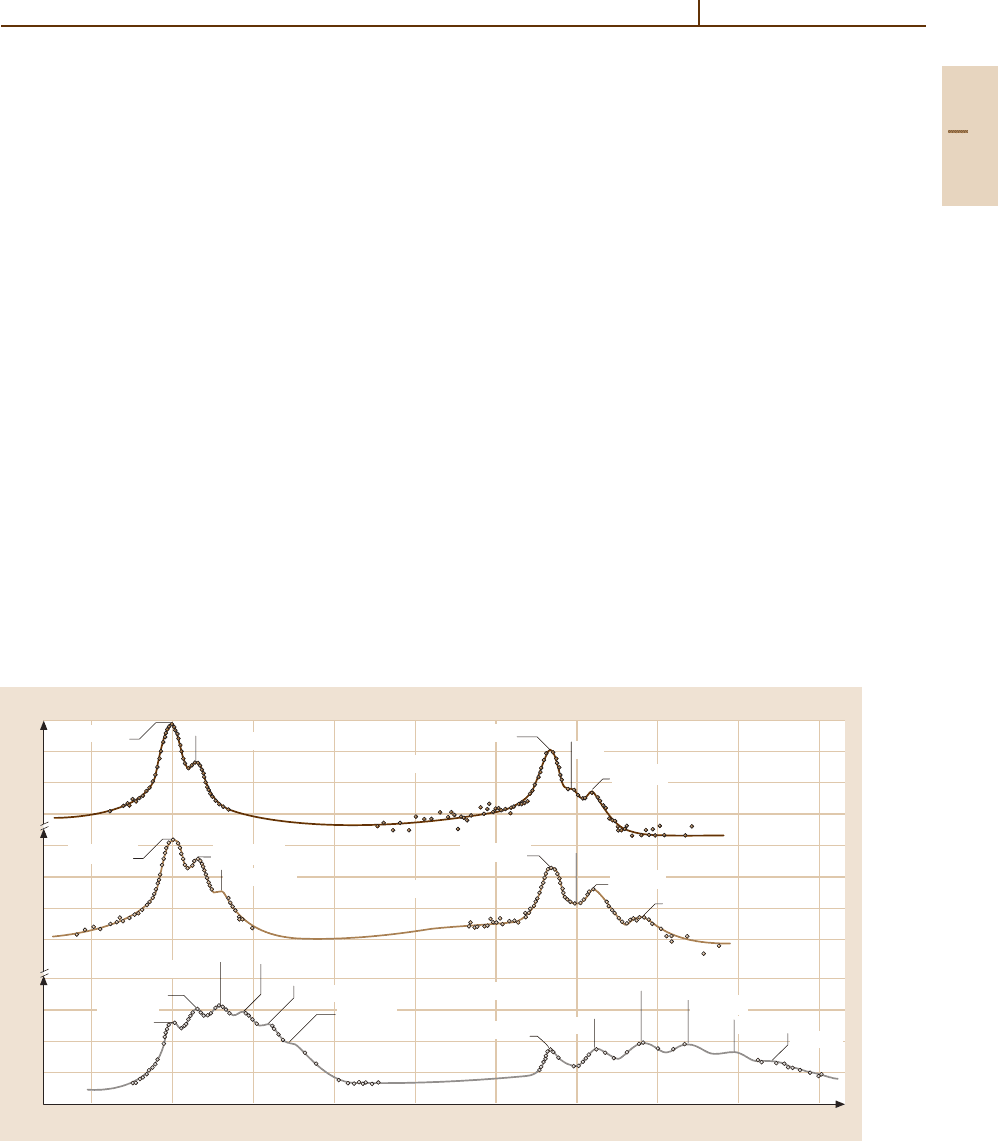
Ion–Atom Collisions – High Energy 65.2 Multi-Electron Processes 957
ability with V and b [65.77, 78]. Both of the above
vacancy production mechanisms are electron transfer
processes rather than direct ionization processes, in that
no inner shell electron need be liberated into the con-
tinuum. Between the perturbation region and the full
MO region the importance of transfer increases rela-
tive to ionization. While the MO correlation diagrams
and mechanisms are qualitatively useful, actual close
coupling calculations for both inner and outer shell
processes are often carried out using atomic orbitals
instead of molecular orbitals, as well as other basis
sets (Chapts. 50, 51).
65.2 Multi-Electron Processes
In a single collision between multi-electron partners,
two or more electrons may be simultaneously excited
or ionized. The electric fields created during a violent
ion–atom collision are so large that the probability of
such multi-electron processes can be of order unity.
While there are many similarities between ion–atom col-
lisions and the interaction of atoms with photons (X-rays
or short laser pulses) or electrons, the dominance of
multi-electron processes is very much less common in
the photon and electron cases. As an example, when
a K-shell electron is removed from a target atom by the
passage of a fast highly charged ion through its heart,
the probability that L-shell electrons will be removed
at the same time can be large. This gives rise to target
X-ray and Auger-electron spectra which are dominated
by satellite structure [65.20]. For example, the spectrum
10
4
10
3
10
2
10
1
10
5
10
4
10
3
10
2
10
1
10
4
10
3
10
2
10
1
2.80
Wavelength (Å)
2.70 2.60 2.50 2.40
Number of counts
Kα
1.2
(2p)
6
Kα
3.4
(2p)
5
H
1
+ Ti
E
p
= 0.8 MeV
v
p
= v
α
Kβ
1.3
(2p)
6
Kβ
5
Kβ(2p)
5
Kα
1.2
(2p)
5
Kα
3.4
(2p)
5
Kα
3.6
(2p)
4
He
4
+ Ti
E
α
= 3.2 MeV
Kβ
1.3
(2p)
6
Kβ
3
Kβ(2p)
5
Kβ(2p)
4
Kα(2p)
6
Kα(2p)
3
Kα(2p)
4
Kα(2p)
3
Kα(2p)
2
Kα(2p)
1
O
16
+ Ti
E
α
= 30 MeV
Kβ(2p)
6
Kβ(2p)
5
Kβ(2p)
4
Kβ(2p)
3
Kβ(2p)
2
Kβ(2p)
1
Fig. 65.7 K X-ray spectrum of Ti for various projectiles, showing dominance of multi-electron transitions when
K vacancies are collisionally produced by heavily ionizing projectiles
16
O beam
[65.79]
of X-rays from Ti bombarded by 30 MeV oxygen shows
that the production of the K vacancy is accompanied
by multiple L vacancy production, and that the domi-
nant K X-rays are those of systems which are missing
several L electrons [65.79](Fig.65.7).
When a gas target is used, the recoil target ion is
heavily ionized and/or excited electronically without re-
ceiving much translational kinetic energy. In the impulse
approximation the transverse momentum ∆ p
⊥
received
by the target from a projectile passing at impact par-
ameter b isgivenina.u.by∆ p
⊥
= 2Z
1
Z
2
/bV.This
expression ignores the exchange of electronic trans-
lational momentum but gives a good estimate. The
resulting recoil energies are typically quite small, rang-
ing from thermal to a few eV. This subject has been
reviewed in [65.63,80]. These slow moving recoils have
Part E 65.2
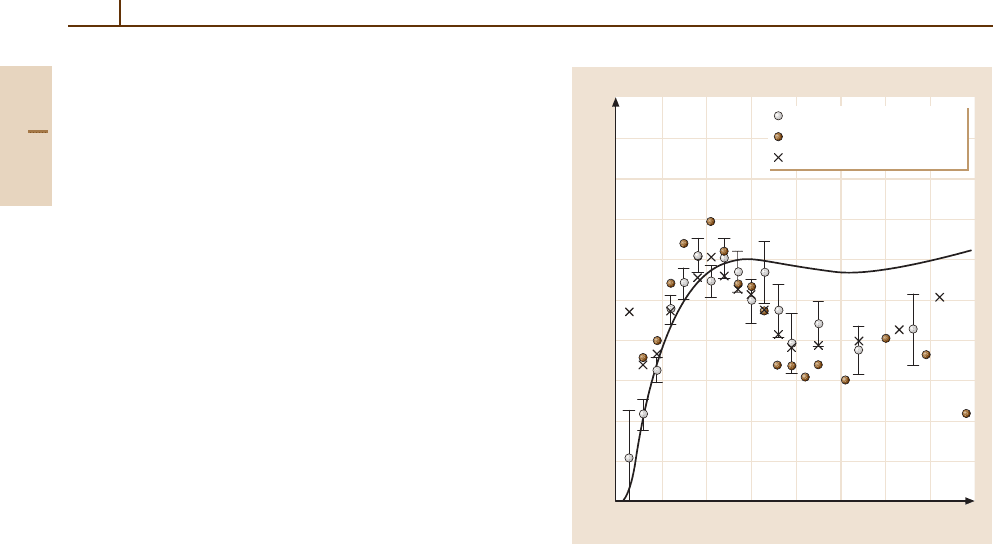
958 Part E Scattering Experiment
been used to provide information about the primary col-
lision dynamics, and as secondary highly charged ions
from a fast-beam-pumped ion source. Such an ion source
has, for moderately charged ions, a high brightness
and has been used extensively for energy-gain measure-
ments. The primary recoil production process is difficult
to treat without the independent electron model, and
even in this model the nonperturbative nature of the col-
lision makes the theory difficult. The most successful
treatments have been the CTMC (see Chapt. 58)and
a solution of the Vlasov equation [65.64].
Studies of many-electron transitions in collisions
of bare projectiles with a He target are particularly
suitable to investigate the role of electron–electron cor-
relation effects because such collisions represent the
simplest systems where the electron–electron inter-
action is present. Such studies have been performed
extensively for a variety of processes, such as dou-
ble ionization, transfer-ionization, double excitation,
transfer-excitation, or double capture (for reviews
see [65.82–84]). It is common to distinguish (somewhat
artificially) between such correlations in the initial state,
the final state, and during the transition (dynamic cor-
relation). From a theoretical point of view, the biggest
challenge is to describe electron–electron correlation
effects and the dynamics of the two-center potential
generated by the projectile and the target nucleus si-
multaneously with sufficient accuracy.
In the case of double ionization, an experimental
method, based on the so-called correlation func-
tion [65.81], was developed to analyze electron–electron
correlations independently of the collision dynamics.
Here, a measured two-electron spectrum (for example
the momentum difference spectrum of both ionized elec-
trons) is normalized to the corresponding spectrum one
would obtain for two independent electrons. An example
of such a correlation function R isshowninFig.65.8 for
three very different collision systems (η
1
ranging from
0.05 to 100 and η
2
from 0.01 to 0.5ina.u.).Thesimilar-
ity in these three data sets illustrates that R is remarkably
insensitive to the collision dynamics. Rather, the shape
of R is determined predominantly by correlations in
the final state [65.81, 85]. However, for selected kin-
ematic conditions, R can also be sensitive to initial-state
correlations [65.86]. Clear signatures of initial-state cor-
relations were found in the recoil-ion momentum spectra
for transfer-ionization [65.87].
Early attempts to identify dynamic correlations were
based on measurements of the ratio of double to single
ionization cross sections [65.88, 89]. From such stud-
ies, it was found that at small V double ionization
0.8
0.4
0.0
–0.4
–0.8
02468
R
p
1
–p
2
(a. u.)
100 MeV/amu C
6+
+ He
3.6 MeV/AMU Au
53+
+ He
3.6 MeV/AMU Au
53+
+ Ne
Fig. 65.8 Correlation function R for double ionization in
the collisions indicated in the legend as a function of the
momentum difference between the two electrons [65.81].
R is defined as R = I
exp
/I
IEM
−1, where I
exp
is the directly
measured momentum spectrum and I
IEM
the one obtained
for independent electrons
is dominated by an uncorrelated mechanism involving
two independent interactions of the projectile with both
electrons. In contrast, at large V the double to single
ionization ratio asymptotically approaches a common
value for all collision systems [65.90]. This is indica-
tive of the dominance of first-order double ionization
mechanisms, where the projectile interacts with only
one electron and the second electron is ionized through
an electron–electron correlation effect. This may either
be a rearrangement process of the target atom adjusting
to a new Hamiltonian (shake-off, an initial-state cor-
relation), or a direct interaction with the first electron
(i. e., dynamic correlation). However, a recent nearly
kinematically complete experiment on double ioniza-
tion in p + He collisions revealed that even at large V
higher-order contributions are not negligible [65.91].
In Fig. 65.9 the ejection angles of both electrons are
plotted against each other for almost completely deter-
mined kinematics. For comparison, the bottom part of
Fig. 65.9 shows the corresponding spectra for electron
impact at the same V [65.92]. For both projectiles, the
basic features of these spectra are determined by the
Part E 65.2
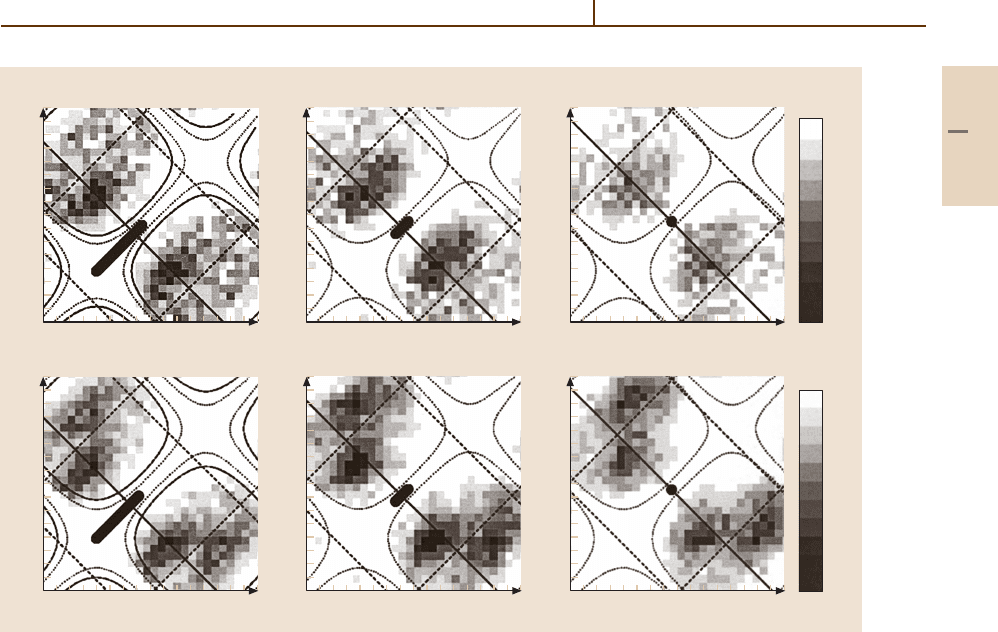
Ion–Atom Collisions – High Energy 65.3 Electron Spectra in Ion–Atom Collisions 959
270
225
180
135
90
45
0
–45
–90
–90 –45 0 45 90 135 180 225 270
270
225
180
135
90
45
0
–45
–90
–90 –45 0 45 90 135 180 225 270
270
225
180
135
90
45
0
–45
–90
–90 –45 0 45 90 135 180 225 270
270
225
180
135
90
45
0
–45
–90
–90 –45 0 45 90 135 180 225 270
270
225
180
135
90
45
0
–45
–90
–90 –45 0 45 90 135 180 225 270
270
225
180
135
90
45
0
–45
–90
–90 –45 0 45 90 135 180 225 270
0
2
4
6
8
10
12
14
16
18
0
6
12
18
24
30
36
42
48
54
60
ϑ
2
b)
ϑ
2
ϑ
1
ϑ
2
c)
ϑ
2
ϑ
1
ϑ
2
a)
ϑ
2
a)
ϑ
1
ϑ
2
d)
ϑ
2
ϑ
1
ϑ
2
e)
ϑ
2
ϑ
1
ϑ
2
f)
ϑ
2
ϑ
1
Fig. 65.9a–f Differential double ionization cross sections in 6 MeV p +He (top)and2keVe
−
+He (bottom) collisions
as a function of the polar emission angle of both electrons, which are emitted into the scattering plane. The electrons have
equal energy and data are shown for small (left), medium (center), and large momentum transfers (right) [65.91]
electric dipole selection rules, which again is indica-
tive of dominating first-order contributions. However,
a closer inspection of the comparison between the pro-
ton and electron impact data shows some non-negligible
differences. Since in a first-order treatment the cross sec-
tions should be identical for both projectile species, this
demonstrates that higher-order contributions cannot be
ignored.
65.3 Electron Spectra in Ion–Atom Collisions
65.3.1 General Characteristics
An ionizing collision between a single ion and a neutral
atom ejects electrons into the continuum via two major
processes. Electrons ejected during the collision form
broad features or continua, and are traditionally referred
to as delta rays; electrons ejected after the collisions
from the Auger decay of vacancies created during the
collision form sharp lines in the spectra. The distribu-
tions of energy and angle of all electrons determine the
electronic stopping power and characteristics of track
formation of ions in matter (Chapt. 91), and the study
of these distributions in the binary encounter of one ion
with one atom form the basis of any detailed understand-
ing of these averaged quantities. Figure 65.10 shows
a typical electron spectrum from the collision of a fast
O ion with O
2
[65.93,94]. Electrons from the projectile
can be identified in the cusp peak (electron loss, P) or
ELC, and the O-K-Auger (P) peak. Electrons from the
target include the soft (large b) collision electrons (T)
which are ejected directly by Coulomb ionization by
the projectile, the binary collision (or encounter) elec-
trons coming from hard collisions between projectile and
quasifree target electrons, and the target O-K-Auger (T)
Part E 65.3
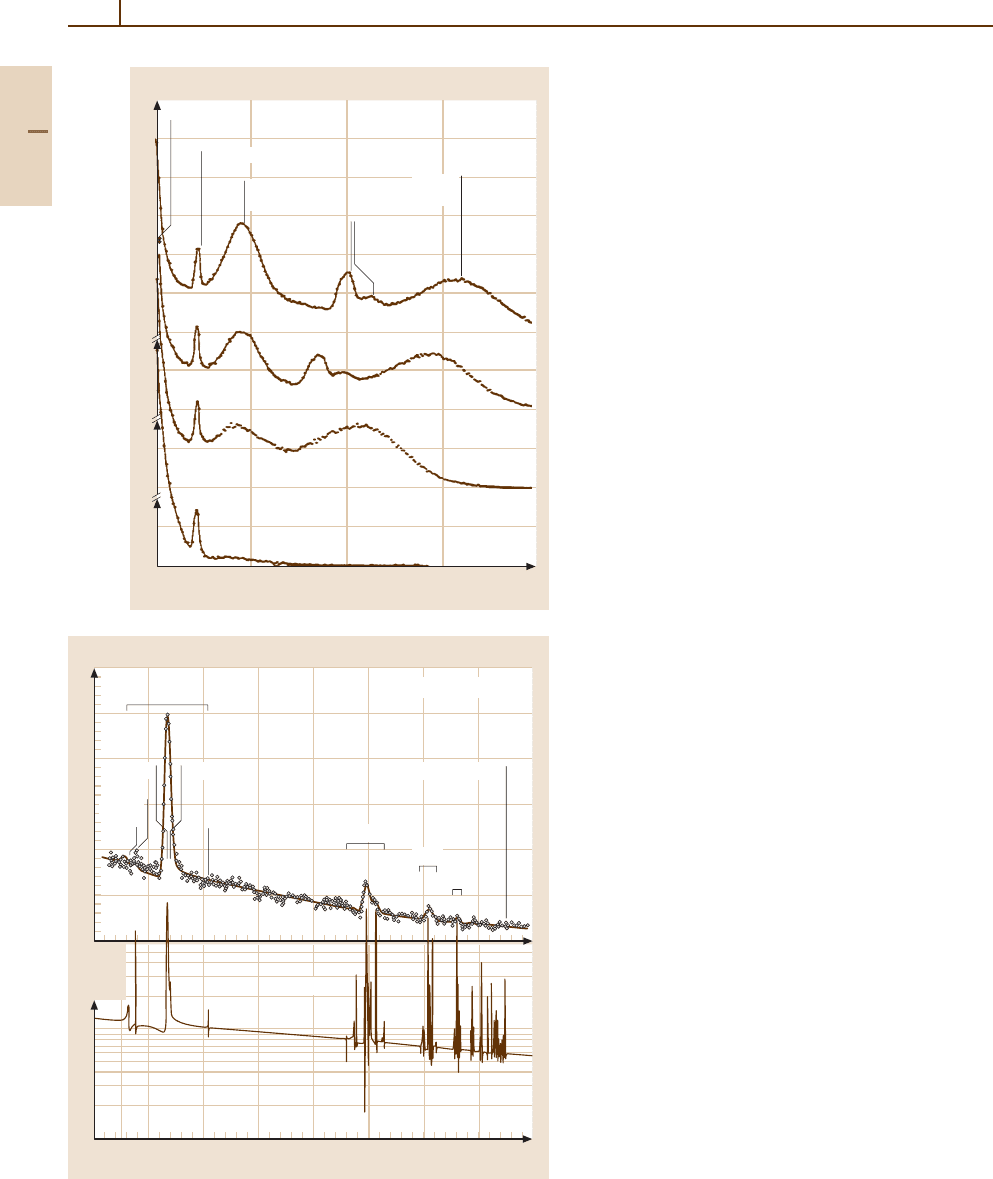
960 Part E Scattering Experiment
6
5
4
3
2
1
0
01234
1
0
1
0
1
Cross section × Electron energy (10
–17
cm
2
/sr)
Electron energy (keV)
3
25°
30°
40°
90°
30 MeV 0
5+
on O
2
Soft collisions (T)
O–K Auger (T)
Electron
loss (P)
O–K
Auger (P)
Binary
collisions (T)
6
5
4
3
2
1
0
180 190 200 210 220 230 240 250 260
(10
–20
cm
2
/eV sr)d
2
σ/ddε
dσ/d
(10
–18
cm
2
/sr)
Electron energy (eV)
2l2l
2s
2 1
S
2s2p
3
P
2p
2 1
D 2s2p
1
P
2p
2 1
S
2l3l
2l4l
2l5l
2lnl Series limit
3.91 MeV B
4+
+ H
2
e
–
+ B
4+
(1s)
Fig. 65.10 Electron spectrum from 30 MeV O on molecular
oxygen. See text for explanation of features [65.93,94]
electrons. The electron loss peak is widely called the
cusp peak because the doubly differential cross section
in the laboratory d
2
σ/ dE dΩ becomes infinite, in prin-
ciple, if it is finite in the projectile frame. In general, this
peak may also contain capture to the continuum. All of
these features have been heavily studied; some reviews
are [65.95, 96]. Capture to the continuum [65.96]isan
extension of normal capture into the continuum of the
projectile, and is not a weak process. Both it and ELC
produce a heavy density of events in the electron mo-
mentum space centered on the projectile velocity vector,
and thus appear strongly only at or near zero degrees in
the laboratory and at v
e
V .
The binary encounter electrons at forward angles
occur at v
e
∼
=
2V . For relatively slow collisions it was
found that the ELC and binary peaks are just part of
a more general and complex structure of the electron
spectra [65.98]. Additional peaks in the forward direc-
tion were found for v
e
∼
=
nV,wheren in principle can be
any integer number. These structures reflect a “bounc-
ing back and forth” (known as Fermi shuttle) between
the projectile and the target core before the electron
eventually gets ejected from the collision system.
In electron spectra for molecular targets, additional
structures were found that were not observed for atomic
targets [65.99]. These were initially interpreted as an
interference effect. The electronic wavefunction has
maxima at the atomic centers of the molecule. Since
in the experiment it cannot be distinguished from which
center the electron is ionized, both possibilities have
to be treated coherently. However, more recent studies
showed that at small electron energies the structures in
the electron spectra reflect vibrational excitation of the
molecule [65.100].
65.3.2 High Resolution Measurements
The Auger electron spectra provide detailed informa-
tion about inner shell vacancy production mechanisms.
Fig. 65.11 High resolution Auger electron spectrum from
H-like B on H
2
, showing resolved lines from doubly ex-
cited projectile states lying on top of a continuum due to
electron elastic scattering [65.97]. The bottom part shows
an R-matrix calculation which does not account for the ex-
perimental resolution. The smooth line in the upper figure is
the R-matrix calculation convoluted with the experimental
spectrometer resolution
Part E 65.3

Ion–Atom Collisions – High Energy 65.4 Quasi-Free Electron Processes in Ion–Atom Collisions 961
When coupled with fluorescence yields, Auger elec-
tron production probabilities and cross sections can be
converted into the corresponding quantities for vacancy
production [65.15, 95]. This is best done when suffi-
cient resolution can be obtained to isolate individual
Auger lines. The Auger spectra in ion–atom collisions
are often completely different from those obtained from
electron or photon bombardment because of the multiple
outer shell ionization which attends the inner shell va-
cancy producing event, in close analogy to X-ray spectra
(see previous section). Projectile Auger electron spectra
suffer from kinematic broadening due to the finite solid
angle of the spectrometer and velocity of the emitter, but
at 0
◦
to the beam this problem vanishes, and the reso-
lution in the emitter frame is actually enhanced by the
projectile motion, such that for electrons with eV ener-
gies in the projectile frame, resolutions in the meV region
are possible [65.101,102]. The highest resolution Auger
lines from ion–atom collisions has been done on the pro-
jectiles. A sample spectrum is shown in Fig. 65.11.From
such high resolution spectra, one-electron processes in
which one electron is excited, captured or ionized can
be distinguished from the configuration of the emitting
state.
65.4 Quasi-Free Electron Processes in Ion–Atom Collisions
At sufficiently low V , those electrons not actively in-
volved in a transition play only a passive role in
screening the Coulomb potential between the nu-
clei, and thereby create a coherent effective potential
for their motion. However, at high V the colliding
electrons begin behaving as incoherent quasifree par-
ticles capable of inducing transitions directly via the
electron–electron interaction. Such processes signal
their presence through their free-particle kinematics,
as if the parent nucleus were not present. For exam-
ple, a projectile ionization process requiring energy U
has a threshold at
1
2
m
e
V
2
U, in collisions with light
targets where the quasifree picture is meaningful. The
threshold is not sharp, due to the momentum dis-
tribution or Compton profile of the target electrons.
Within the impulse approximation, the cross section
for any free electron process can be related to the cor-
responding cross section for the ion–atom process by
folding the free electron cross section into the Compton
profile [65.97,103, 104].
65.4.1 Radiative Electron Capture
The first quasifree electron process to be observed was
radiative electron capture (REC), the radiative capture
of a free electron by an ion. Conservation of energy
and momentum is achieved by the emission of a photon
which carries away the binding energy. The cross sec-
tion exceeds that for bound state capture at high V .
Radiative electron capture was observed through the
X-ray spectra from fast heavy projectiles for which the
electrons of light targets appear to be ‘quasi-free’. The
corresponding free electron process was seen [65.105]
and has recently been heavily studied in EBIT [65.106],
cooler [65.107], and storage rings [65.108]. Total cross
sections for REC have also been deduced from meas-
ured total capture cross sections at large V where REC
dominates bound state capture [65.109]. At high vel-
ocities, the cross section for radiative capture to the
K-shell of a bare projectile is given approximately
by
σ
n
=
n/
κ
−2
+κ
−4
×2.1×10
−22
cm
2
, (65.6)
where [65.110] κ =
√
E
B
/E
0
, E
B
is the binding en-
ergy of the captured electron, E
0
the energy of the
initial electron in the ion frame and n the princi-
pal quantum number of the captured electron. The
theory seems to be in good agreement with experi-
ment for capture to all shells of fast bare projectiles,
although a small unexplained discrepancy between
theory and experiment exists for capture to the
K-shell [65.108].
65.4.2 Resonant Transfer and Excitation
Dielectronic recombination in electron–ion collisions
is the process whereby an incident electron excites
one target electron and, having suffered a correspond-
ing energy loss, drops into a bound state on the
projectile (Chapt. 55). If the doubly excited state so
populated decays radiatively, resonant radiative recom-
bination is achieved (DR); if it Auger decays, resonant
elastic scattering has occurred. The process has long
been known to be important as a recombination pro-
cess in hot plasmas [65.111], but was not observed
in the laboratory until 1983 [65.112–114]. The corres-
ponding ion–atom process, known as resonant transfer
and excitation (RTE) was seen a bit earlier by Tanis
et al. [65.115]. (See [65.116, 117] for reviews of both
DR and RTE.)
Part E 65.4
